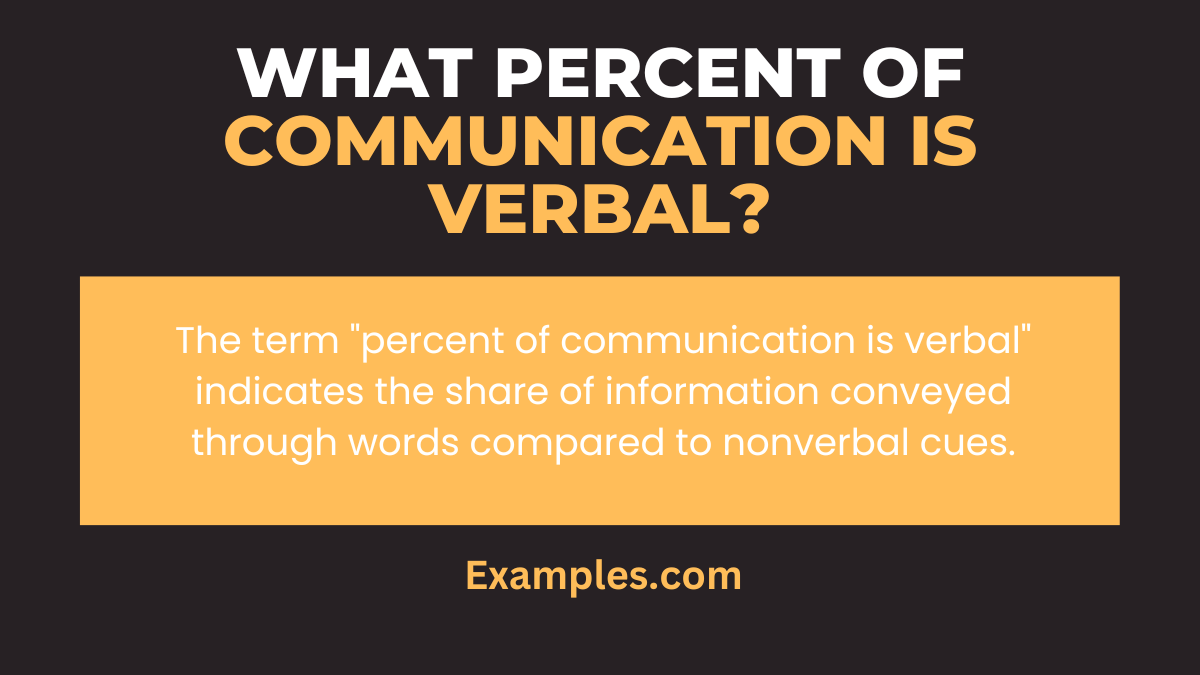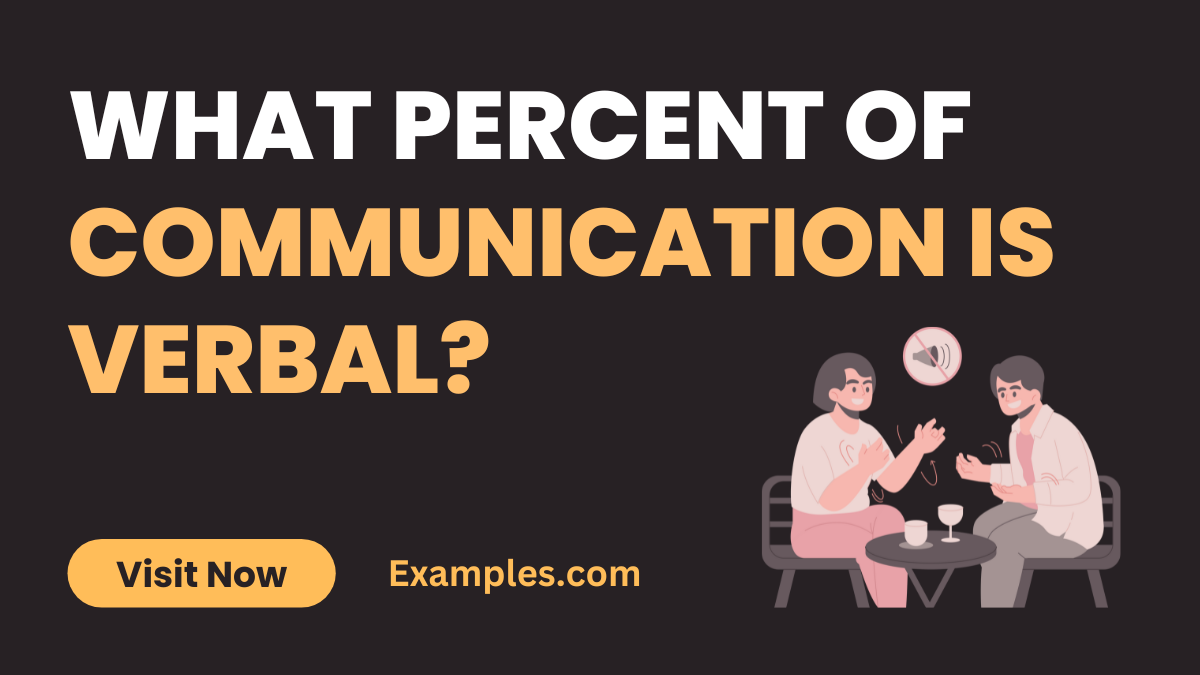What Percent of Communication is Verbal?
Dive into the fascinating world of verbal communication with this all-encompassing guide. Delve into Communication Examples that illustrate the surprising and significant role verbal elements play in our daily interactions. This guide will explore theories, percentages, and the profound impact of words in conveying messages, emotions, and intentions. Understand the balance and effectiveness of verbal communication in the tapestry of human interaction, enhancing both personal and professional relationships.
What Percent of Communication is Verbal? – Meaning

What percent of communication is verbal refers to the proportion of message conveyed through words in contrast to nonverbal elements like tone, facial expressions, and body language. While the exact percentage varies depending on the context and interaction, verbal communication is often seen as the cornerstone of conveying explicit information, with various studies and theories contributing to understanding its exact impact and effectiveness in our everyday communication.
What Percentage of Verbal Communication is Never Heard?
A significant percentage of verbal communication may never be effectively heard or understood due to various barriers and misinterpretations. Understanding this helps in enhancing the clarity and effectiveness of our spoken words. Incorporating effective Verbal Communication Techniques and continually improving your Verbal Communication Skills can significantly decrease the percentage of verbal communication that goes unheard. Recognizing the Functions of Verbal Communication and understanding the Advantages and Disadvantages of Verbal Communication are vital in adapting your strategies. Additionally, exploring different Types of Verbal Communication and real-life Verbal Communication Examples can provide a clearer insight into crafting messages that are heard, understood, and remembered. Explore the nuances of What Percent of Communication is Verbal? with these five detailed aspects:
- Distractions and Noise: External noise or internal distractions can lead to missing out on words. Mitigate by seeking quieter environments for important conversations.
- Inattention: Sometimes listeners don’t fully focus. Encourage active listening by engaging the audience with questions or visual aids.
- Mismatched Communication Styles: Different speaking and listening styles can lead to misunderstandings. Adapt your message to suit the listener’s style for better comprehension.
- Overwhelming Information: Too much information can overload the listener. Use clear, concise language and break information into manageable parts.
- Emotional Barriers: Emotions can cloud interpretation. Ensure emotional states are conducive to communication, and address any emotional barriers beforehand.
What is the Importance of Percent of Communication is Verbal?
Understanding the percent of communication that is verbal is crucial in enhancing interpersonal interactions across various domains. Recognizing the value of words alongside nonverbal cues is vital for effective exchange, whether it’s in healthcare, business, or education. Here are five steps emphasizing its importance:
- Clarifies Intent in Healthcare: In Verbal Communication in Healthcare, clear verbal communication is life-saving. It ensures patients receive and understand medical information accurately, reducing errors and improving health outcomes.
- Enhances Team Collaboration in the Workplace: Effective Verbal Communication in the Workplace fosters better teamwork, understanding, and productivity. It’s about ensuring messages are clearly understood and acted upon.
- Drives Business Negotiations and Deals: In Verbal Communication in Business, every word counts. Clear verbal exchanges lead to better negotiations, clearer contracts, and more successful business relationships.
- Improves Teaching and Learning Process: For Verbal Communication for Teachers, it’s about making complex ideas accessible and engaging, ensuring students understand and retain information effectively.
- Develops Personal and Professional Growth: Implementing Ways to Improve Verbal Communication Skills not only enhances personal relationships but also opens doors to professional opportunities, making it a lifelong beneficial endeavor.
What Percentage of Communication is Typically Considered to be Verbal in Interpersonal Interactions?
In interpersonal interactions, the verbal component of communication is pivotal yet varies. It’s essential in contexts like Verbal Communication for Students, Verbal Communication in Law Enforcement, and more. Here are five aspects that illustrate the typical percentage of verbal communication and how to enhance it:
- Understanding Context: Recognize that in interpersonal interactions, the verbal part often carries the explicit content of the message, but its impact is influenced by nonverbal cues. This understanding is crucial in environments like schools and law enforcement, where clarity and precision are necessary.
- Importance of Tone and Clarity: In Verbal Communication for Students and Verbal Communication for School, it’s essential to use a tone and clarity that matches the educational environment to facilitate learning and understanding.
- Adapting to Audience Needs: For sensitive communication, such as Verbal Communication for Autism, adapting the verbal message to fit the cognitive and emotional needs of the audience is crucial. This means choosing words carefully and considering the pace and complexity of speech.
- Professional Communication Techniques: In Verbal Communication in Law Enforcement, the verbal percentage is significant for issuing commands, gathering information, and providing public service. Effective training in communication techniques is vital for clarity and safety.
- Continuous Improvement: Regardless of the percentage, enhancing verbal communication is a continuous process. Engaging in activities and training to Improve Verbal Communication Skills benefits all aspects of interpersonal interaction, ensuring that the verbal message is as effective as possible.
What Strategies can Individuals Use to Improve their Verbal Communication Skills?
Understanding Why you need Verbal Communication Skills and acknowledging the Importance of Verbal Communication are the first steps toward improvement. Verbal communication is vital for effective interaction in personal and professional settings. Following the Rules of Verbal Communication can greatly enhance your ability to express ideas clearly and understand others. Here are five strategies to improve your verbal communication skills:
- Listen Actively: Improve your ability to understand others and respond appropriately by practicing active listening. This means fully concentrating, understanding, responding, and remembering what is being said.
- Expand Your Vocabulary: A rich vocabulary allows you to express yourself clearly and concisely. Read widely, learn new words, and practice using them in appropriate contexts.
- Engage in Public Speaking: Enhance your speaking skills by engaging in public speaking or joining groups like Toastmasters. Practice makes perfect, and exposure reduces anxiety.
- Be Mindful of Your Tone and Pitch: The way you say something can impact the message’s reception. Practice modulating your tone and pitch to convey your message effectively.
- Seek Feedback and Reflect: After conversations or presentations, seek feedback on your verbal communication. Reflect on what you did well and what could be improved. Use this insight for continuous learning and development.
In exploring Verbal vs Written Communication and Verbal vs Oral Communication, it’s clear that verbal interaction is a critical component of Effective Communication. Understanding the nuances, examples, and strategies for improvement can significantly enhance how we convey and interpret messages. Embrace these insights to refine your verbal Communication Skills and navigate both personal and professional dialogues more effectively.



